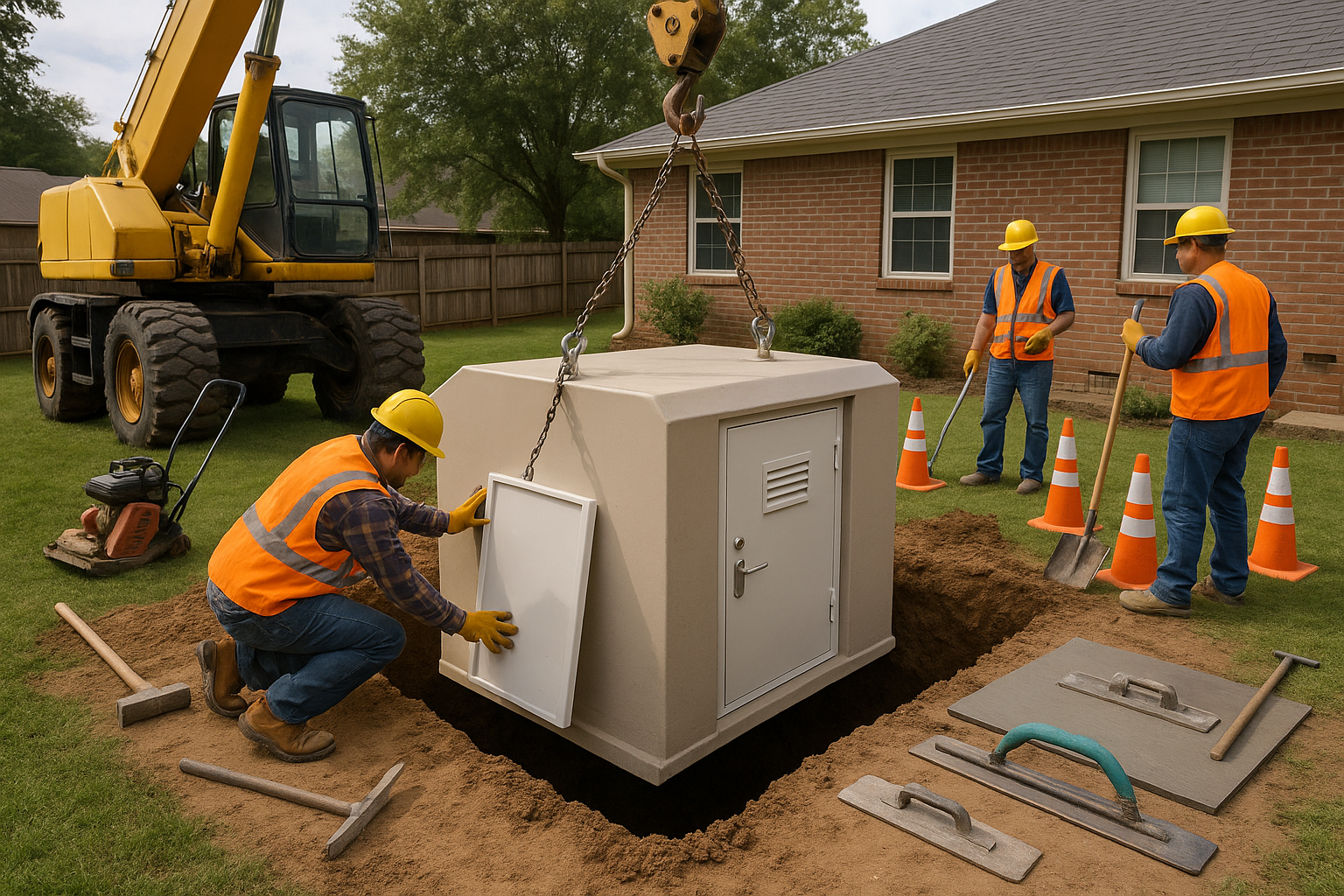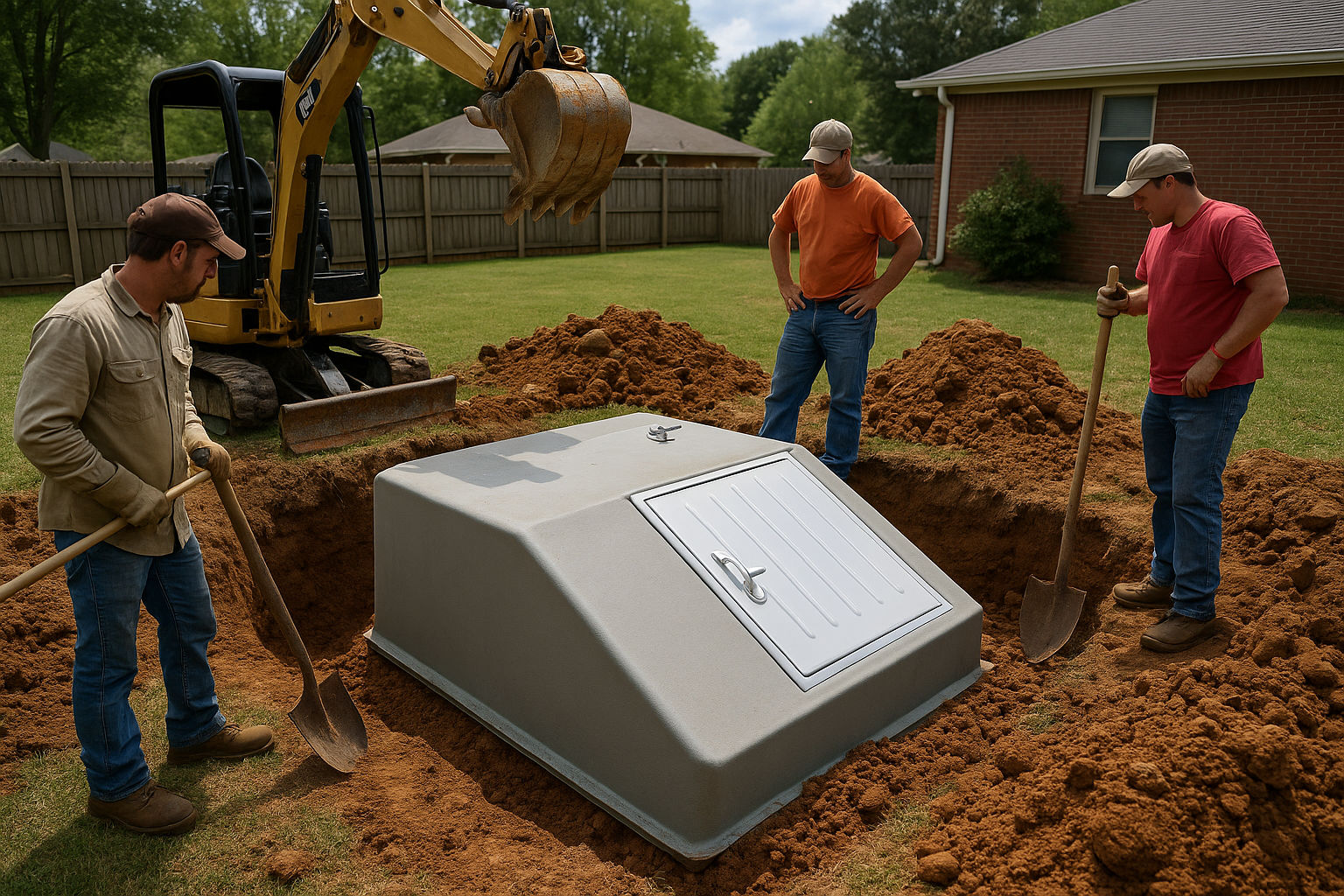How to Install a Storm Shelter Step by Step


Understanding the Importance of Storm Shelter Installation
When Alabama weather turns severe, having a properly completed storm shelter installation can mean the difference between safety and disaster. Tornadoes and extreme weather events are a regular part of life in the South, and preparation is critical. Yet, many homeowners still delay installing shelters because they’re unsure where to begin or how much to install a storm shelter.
A storm shelter installation isn’t just about placing a structure underground or anchoring a steel unit to concrete. It’s a life-saving project that requires planning, compliance, and precision. Whether you are building a new home or improving an existing one, understanding each step helps you make informed, safe, and cost-effective decisions.
By the end of this guide, you’ll understand how to select the right shelter, prepare your property for installation, calculate the cost to install a storm shelter, and meet FEMA-approved safety standards so you can confidently survive a storm shelter installation even during unpredictable Alabama weather.
Choosing the Right Type of Storm Shelter for Alabama Homes
Choosing the right shelter type is essential, and Alabama’s unique landscape makes this decision even more significant. The choice also affects how much does it cost to install a storm shelter, since labor and preparation vary by soil conditions and shelter style.
Here are the primary options:
Underground Storm Shelters
Underground storm shelters offer exceptional tornado protection and conserve yard space. They are ideal for areas with stable soil and good drainage. Homeowners exploring underground storm shelter installation can review durable, FEMA-rated models on the Underground Shelters page from Lake Martin Storm Shelters.
Above Ground Storm Shelters
Above ground shelters are ideal for flood-prone areas and provide easier access. They are frequently installed in garages, basements, or exterior pads. These shelters are especially popular for aging homeowners or those needing wheelchair-accessible spaces.
You can explore reinforced steel and concrete designs through the Above Ground Shelter collection or theUnpainted Concrete Shelter options.
If you prefer to attach your shelter to an existing structure, consider a garage storm shelter installation, which gives fast access during emergencies without going outside.
Community and Commercial Storm Shelters
These larger, reinforced structures protect groups of people during extreme weather events. Explore available models on the Community Storm Shelters page.
Key Benefits of Choosing the Right Shelter
- Reduces injury risk during tornadoes and hurricanes
- Ensures compliance with Alabama safety and FEMA requirements
- Increases home value and insurance confidence
- Helps estimate the cost to install a storm shelter accurately
Many homeowners assume all shelters function the same, but soil composition, flood risk, accessibility, and shelter materials all influence safety and how much to install a storm shelter in Alabama.
Step-by-Step Storm Shelter Installation Process in Alabama
A successful install storm shelter project requires accuracy and adherence to both local and national safety standards. Each step plays a vital role, especially when your goal is to safely survive a storm shelter installation during unpredictable weather.
Step 1: Conduct a Site Evaluation and Choose the Location
Begin by assessing the soil type, water table depth, and underground utilities. Alabama’s clay-heavy soil can hold moisture, which affects drainage and long-term stability. Professional soil assessments help ensure your shelter is placed in the safest possible location.
Your soil rating, water levels, and excavation requirements directly influence how much does it cost to install a storm shelter.
Step 2: Obtain Necessary Permits and Review FEMA Guidelines
Each Alabama county has its own zoning and permit requirements. Review the FEMA P-320 guidelines and ICC 500 safety standards through:
Submitting complete documentation ensures your shelter meets standards for anchoring, wind-load resistance, and reinforced construction.
Step 3: Prepare the Ground and Foundation
Ground preparation is one of the most critical parts of storm shelter installation.
For underground storm shelter installation, preparation includes:
- Excavation to the required depth
- Installing drainage systems
- Compacting soil around the shelter
- Waterproofing the area
For above ground storm shelter installation or garage storm shelter installation, installers must ensure the concrete pad is level, reinforced, and capable of supporting heavy loads.
Failing to waterproof or level the ground increases long-term maintenance and affects the overall cost to install a storm shelter.
Step 4: Install the Storm Shelter Structure
Once the foundation is ready, installers position the structure:
- Underground units are lowered into the excavated space using mechanical lifts.
- Above-ground shelters are bolted into concrete pads with industrial-grade anchor bolts.
Installers then check:
- Door seal strength
- Locking mechanisms
- Ventilation
- Interior safety features
Proper anchoring is essential to avoid uplift during tornado conditions.
Step 5: Seal, Ventilate, and Finalize the Installation
A shelter must stay airtight while still allowing healthy ventilation. Installers seal seams with industrial caulking, test airflow components, and confirm structural integrity.
For deeper insight into structural mechanics, review the guide How Storm Shelters Work in Alabama.
Practical Applications and Real-World Use Cases
Case 1: Tuscaloosa Homeowner
A family installed an underground concrete shelter to protect against frequent tornado warnings. Their project took two days and complied fully with FEMA guidelines.
Case 2: Baldwin County Resident
With a high water table, this homeowner chose an above-ground steel safe room. It doubles as a hurricane-safe space.
Case 3: Montgomery Business
A small company reinforced a storage room, turning it into a FEMA-rated commercial shelter. This upgrade helped them qualify for a safety grant.
These cases show how flexible storm shelter installation solutions can be across Alabama’s diverse terrain.
Expert Tips and Common Mistakes to Avoid
Choose the Right Material
Concrete, steel, and fiberglass each perform differently depending on moisture levels and exposure.
Check for Proper Drainage
Poor drainage increases maintenance issues and can raise the cost to install a storm shelter over time.
Secure All Anchors
Loose anchor bolts are a common failure point. Annual inspections ensure long-term stability.
Avoid DIY Shortcuts
Skipping sealing, vent installation, or bolt tightening can create major safety hazards.
Keep an Emergency Kit Ready
Prepare lighting, radios, food, water, and first-aid supplies so your shelter is ready during sudden alerts.
Building Long-Term Safety for Alabama Families
A storm shelter installation is more than a home upgrade—it’s long-term safety for your family. From evaluating soil conditions to securing the last anchor bolt, every step contributes to reliable protection against Alabama’s unpredictable climate.
To explore FEMA-rated safe rooms and secure designs, visit the Safe Rooms Collection.
Frequently Asked Questions (FAQs)
1. How much does storm shelter installation cost in Alabama?
The cost to install a storm shelter typically ranges from $3,000 to $7,500, depending on:
- Size
- Materials
- Above-ground vs. underground design
- Excavation and labor needs
- Drainage preparation
These factors also affect how much does it cost to install a storm shelter long term.
2. Can I install a storm shelter myself?
Yes, but DIY installation is best for experienced builders familiar with engineering and safety codes. Most homeowners hire professionals to ensure proper anchoring, ventilation, waterproofing, and FEMA compliance.
3. What’s the difference between above-ground and underground shelters?
- Above-ground: Easier access; recommended for flood-prone areas.
- Underground: Offers superior tornado resistance but requires excavation and stable soil.
4. Do storm shelters require maintenance?
Yes. Annual checks of bolts, seals, ventilation, and interior condition help extend the shelter’s lifespan.
5. Are all storm shelters FEMA-approved?
No. Only units meeting FEMA P-320 and ICC 500 standards are certified. Always check specifications when comparing the cost to install a storm shelter.



